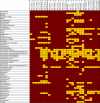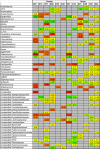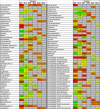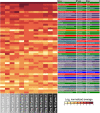A Consistent and Predictable Commercial Broiler Chicken Bacterial Microbiota in Antibiotic-Free Production Displays Strong Correlations with Performance
- PMID: 29625981
- PMCID: PMC5981067
- DOI: 10.1128/AEM.00362-18
A Consistent and Predictable Commercial Broiler Chicken Bacterial Microbiota in Antibiotic-Free Production Displays Strong Correlations with Performance
Abstract
Defining the baseline bacterial microbiome is critical to understanding its relationship with health and disease. In broiler chickens, the core microbiome and its possible relationships with health and disease have been difficult to define, due to high variability between birds and flocks. Presented here are data from a large, comprehensive microbiota-based study in commercial broilers. The primary goals of this study included understanding what constitutes the core bacterial microbiota in the broiler gastrointestinal, respiratory, and barn environments; how these core players change across age, geography, and time; and which bacterial taxa correlate with enhanced bird performance in antibiotic-free flocks. Using 2,309 samples from 37 different commercial flocks within a vertically integrated broiler system and metadata from these and an additional 512 flocks within that system, the baseline bacterial microbiota was defined using 16S rRNA gene sequencing. The effects of age, sample type, flock, and successive flock cycles were compared, and results indicate a consistent, predictable, age-dependent bacterial microbiota, irrespective of flock. The tracheal bacterial microbiota of broilers was comprehensively defined, and Lactobacillus was the dominant bacterial taxon in the trachea. Numerous bacterial taxa were identified, which were strongly correlated with broiler chicken performance across multiple tissues. While many positively correlated taxa were identified, negatively associated potential pathogens were also identified in the absence of clinical disease, indicating that subclinical dynamics occur that impact performance. Overall, this work provides necessary baseline data for the development of effective antibiotic alternatives, such as probiotics, for sustainable poultry production.IMPORTANCE Multidrug-resistant bacterial pathogens are perhaps the greatest medical challenge we will face in the 21st century and beyond. Antibiotics are necessary in animal production to treat disease. As such, animal production is a contributor to the problem of antibiotic resistance. Efforts are underway to reduce antibiotic use in animal production. However, we are also challenged to feed the world's increasing population, and sustainable meat production is paramount to providing a safe and quality protein source for human consumption. In the absence of antibiotics, alternative approaches are needed to maintain health and prevent disease, and probiotics have great promise as one such approach. This work paves the way for the development of alternative approaches to raising poultry by increasing our understandings of what defines the poultry microbiome and of how it can potentially be modulated to improve animal health and performance.
Keywords: antibiotic free; broilers; chickens; microbiome; performance; poultry.
Copyright © 2018 American Society for Microbiology.
Figures











References
-
- Lin Y, Xu S, Zeng D, Ni X, Zhou M, Zeng Y, Wang H, Zhou Y, Zhu H, Pan K, Li G. 2017. Disruption in the cecal microbiota of chickens challenged with Clostridium perfringens and other factors was alleviated by Bacillus licheniformis supplementation. PLoS One 12:e0182426. doi:10.1371/journal.pone.0182426. - DOI - PMC - PubMed
-
- Macdonald SE, Nolan MJ, Harman K, Boulton K, Hume DA, Tomley FM, Stabler RA, Blake DP. 2017. Effects of Eimeria tenella infection on chicken caecal microbiome diversity, exploring variation associated with severity of pathology. PLoS One 12:e0184890. doi:10.1371/journal.pone.0184890. - DOI - PMC - PubMed
-
- Awad WA, Mann E, Dzieciol M, Hess C, Schmitz-Esser S, Wagner M, Hess M. 2016. Age-related differences in the luminal and mucosa-associated gut microbiome of broiler chickens and shifts associated with Campylobacter jejuni infection. Front Cell Infect Microbiol 6:154. doi:10.3389/fcimb.2016.00154. - DOI - PMC - PubMed
-
- Abudabos AM, Al-Atiyat RM, Albatshan HA, Aljassim R, Aljumaah MR, Alkhulaifi MM, Stanley DM. 2017. Effects of concentration of corn distillers dried grains with solubles and enzyme supplementation on cecal microbiota and performance in broiler chickens. Appl Microbiol Biotechnol 101:7017–7026. doi:10.1007/s00253-017-8448-5. - DOI - PubMed
Publication types
MeSH terms
Substances
LinkOut - more resources
Full Text Sources
Other Literature Sources
Research Materials

